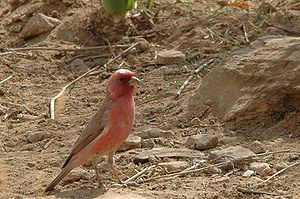Lonely bullfinch
| Lonely bullfinch | ||||||||||||
|---|---|---|---|---|---|---|---|---|---|---|---|---|

Male of the single gimp ( Carpodacus synoicus ) |
||||||||||||
| Systematics | ||||||||||||
|
||||||||||||
| Scientific name | ||||||||||||
| Carpodacus synoicus | ||||||||||||
| ( Temminck , 1825) |
The Einödgimpel ( Carpodacus synoicus ) or Sinaigimpel is a songbird from the finch family . The inconspicuously colored carmine pimple species inhabits four widely separated islands from Sinai to western China. It occurs in mountainous deserts.
description
Appearance
At 14.5–16 cm, the Einödgimpel is about the size of a green . Compared to other carmines , it is relatively inconspicuous in color and shows no clear markings such as wing bands or stripes. The wing length is 83-91 mm.
The sexes differ in the color of the plumage. The female is completely beige to sand gray in color without reddish areas and only slightly lighter on the underside. The large plumage is darker sand-colored. The slightly darker feather centers on the head and back as well as the slightly lighter hems on the wings and umbrella feathers are hardly noticeable. The male also shows a dark red color on the face and throat, which continues as dark to light pink areas on the underside and the head. The upper side of the nominate form is often tinged with reddish. The rump is also colored pink. The youth dress is similar to that of the female. Young males form the reddish parts from the first summer, which are only fully colored in the second winter.
voice
The flight call is a strong trzip that resembles that of the tree pipit. Further calls are a bunting-like tiu , a tschig and a sparling- like twiet or tschipp-tschipp . The female's calls are more subdued. The singing is a melodic chirping that is interspersed with whirring sounds.
Distribution and geographic variation
The strongly disjointed distribution area is divided into four small sub-areas and extends from the Middle East to western China. The four sub-areas each fall into one subspecies. These differ in the extent of the reddish plumage parts, which are missing on the back of the more eastern ones and are sometimes less pronounced on the underside. The subspecies salimanii also has white under tail-coverts .
- C. s. synoicus ( Temminck , 1825) - Negev and Sinai desert , western Jordan and northwestern Saudi Arabia
- C. s. salimalii ( Meinertzhagen , 1938) - northeastern Afghanistan
- C. s. stoliczkae ( Hume , 1874) - Eastern Qinghai to the Yarkant and the western edge of the Kunlun to southwestern Xinjiang
- C. s. beicki ( Stresemann , 1930) - Northwestern Gānsù to eastern Qīnghǎi
The species is only common in places and mostly rare, but not threatened.
hikes
The Einödgimpel is a stationary bird or line bird , which sometimes migrates from higher elevations to neighboring valleys or coastal areas in winter. The species tends to dismigrate .
Way of life
The Einödgimpel inhabits bare, desert mountain regions up to 3350 m above sea level. It occurs on mountain slopes, in rocky deserts, wadis, cliffs and gorges, sometimes on ruins. Water points within easy reach are important. The species can usually be found in small groups of up to 10–12 specimens, sometimes in flocks of up to 50 birds. In the morning and in the afternoon, and sometimes also at noon, they cover significant distances on the way to the water points. Artificial water sources such as water basins or fountains that are located in human settlements or buildings are also sought out for drinking.
The nest is created at the foot of cliffs or higher up in crevices. The diet consists of seeds, leaves, shoots and buds and - where possible - fruits.
The species is relatively shy and can easily be overlooked due to its plumage.
literature
- P. Clement, A. Harris, J. Davis: Finches and Sparrows. Helm Identification Guides, London 1993/1999, ISBN 0-7136-5203-9 .
- L. Svensson, PJ Grant, K. Mularney, D. Zetterström: The new cosmos bird guide. Franckh-Kosmos Verlags-GmbH, Stuttgart 1999, ISBN 3-440-07720-9 .
Web links
- Carpodacus synoicus in the endangered Red List species the IUCN 2009. Posted by: BirdLife International, 2009. Retrieved on 4 March of 2010.
- Videos, photos and sound recordings of Carpodacus synoicus in the Internet Bird Collection
- Photos at orientalbirdimages.org , accessed March 3, 2010